Text and photos © 2008
Are you contemplating a trip to Sicily? Once you’ve read even just one of Mary Taylor Simeti’s several books for background, I promise you’ll be winging towards Palermo in no time.
With both a native’s intimacy and the fresh-eye of an outsider, in her first book On Persephone’s Island: A Sicilian Journal (Random House, 1986, paperback 1995) Simeti chronicles a year on Sicily, the Mediterranean island that both she and the Greek goddess of the harvest call home. Pomp and Sustenance: Twenty-Five Centuries of Sicilian Food (1989, paperback 1998, now out-of-print, but available from www.amazon.com) celebrates one of the oldest and best-loved cuisines of Europe, and one of the most varied, because of all the foreign conquests: Phoenician, Greek, Carthaginian, Roman, Byzantine, Arab,
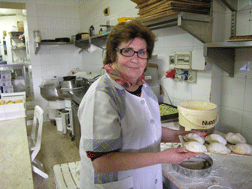
Maria Grammatico
Norman, and Spanish. Bitter Almonds: Recollections and Recipes of a Sicilian Girlhood (1994, paperback 2003, also out-of-print, but available from www.amazon.com) is an account with recipes of Maria Grammatico’s childhood in a convent in the beautiful hill town of Erice, high above the port city of Trapani, where she and her fellow orphans learned to make the almond pastries she has since sold in her several shops. Travels with a Medieval Queen (2001, paperback 2003), reconstructs the yearlong journey undertaken in 1194-95 by the Sicilian princess Constance from Germany back to her ancestral island in the company of her cold, conquering husband, the Holy Roman Emperor Henry VI. According to the review on www.amazon.com, “in the book’s twelve chapters, corresponding to the months of Constance’s trip, Simeti renders her sense of connection with her subject: they are both expatriates caught between two cultures, maneuvering for space in a male world.” Her last book Sicilian Food (1995, the British edition of Pomp and Sustenance, now out-of-print, but soon to be reprinted as well as issued as an e-book) describes her favorite Sicilian dishes and their recipes. During the last decade Simeti has contributed numerous articles on Sicily to New York Times’ travel section and “Sophisticated Traveler” and co-authored with Marcella Croce and Moira F. Harris History of the Road: The Painted Carts of Sicily (2006).
About fifteen years ago I first heard Mary Taylor Simeti give a lecture about her life on Sicily at a ladies club in Manhattan where we both grew up before moving to Italy. Then last spring I finally had the pleasure of meeting her and her Sicilian husband Tonino during the Oldways Symposium on the Mediterranean Diet and Sicilian olive oil held in Palermo from April 21-27 and sponsored by The Region of Sicily, The Presidency of the Sicilian Region, the Council Department of Agriculture, the Italian Regional Institute of Olive Trees and Olive Oil. Simeti gave the symposium’s opening address and then accompanied us around Palermo, to the Greek temple at Segesta and to Erice, and to two olive-producing agriturismi in northern Sicily: Azienda Fontanasalsa (www.fontanasalsa.it, tel. -0923-591120) and Masseria Sgadari (www.masseriasgadari.com, tel.-0921-687190 or mobile -3355257895). An Epicurean-Traveler in persona, she graciously agreed to this interview for www.epicurean-traveler.com.
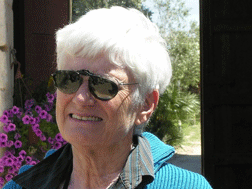 |
|
Mary Taylor Simeti
|
When and why did you come to live in Italy?
MTS: I came to stay a year and never went home. When I graduated from Radcliffe I was
undecided as to whether I wanted to do development work or go on in medieval history. It was the Peace Corps period, but I didn’t want to join. I wanted to do something on my own, so I volunteered to work with the Sicilian social activist Danilo Dolci for a year thinking that would help me make up my mind about graduate school. I describe my train journey from Florence to Palermo in an excerpt from On Persephone’s Island, published in a splendid collection of foreign women writers’/long term residents’ of Italy reminiscences called Desiring Italy (1997).
Had you traveled to Italy as a child?
MTS: Yes, I’d come in 1955 when I was thirteen and traveled around Italy, but not south of Rome, with my parents. Then, after my father died, my mother lived in Florence for ten years and so I visited her several times there while I was at Radcliffe. She was running a school: the Villa Mercede, which was started by an American woman who was killed in a plane crash. Her daughter wanted to keep it open so my mother took the job until it closed in 1968.
How did you first hear of the Sicilian social reformer Danilo Dolci?
MTS: He was well-known in the States. I had tried to get a job with agencies like CARE, but my major at Radcliffe was in medieval history, not exactly good preparation for practical social work. I had no qualifications so I had to find a volunteer situation. As a matter a fact, the work at the Dolci Center had become much more professional, but I was lucky to be the right person at the right time. I applied just as their only English-speaking employee was leaving.
What did you actually do for him?
MTS: During 1962-3 I worked in the office, doing translations, welcoming English-speaking guests. Eventually I became Acting Secretary-General standing in for a Norwegian who’d taken a leave of absence to complete a PhD thesis.
How did you meet your husband Tonino?
MTS: Through friends who worked at the Dolci Center. Tonino hung out around the Center a lot.
He told me that you were married here in Sicily.
MTS: The US consulate wouldn’t give him a visa to come to the States. We had a small, civil wedding followed by a lunch here in Palermo in 1964. I didn’t want a big wedding anyway. My mother came, but she was very pessimistic about cross-cultural marriages. She had American women friends in Florence with traditional old-fashioned Italian husbands with mistresses.
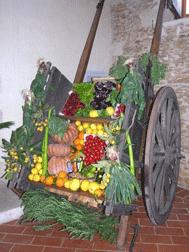 |
|
Produce cart at Azienda Fontanasalsa
|
What did she say when you told her that you were marrying an Italian and a Sicilian no less?
MTS: “Mary, remember there’s no divorce in Italy”, to which I answered: “That’s OK because there’s divorce in America, so the one who would be out of luck will be Tonino. Besides, Mother, as an academic, I don’t think Tonino will ever have the money to maintain a whole slew of mistresses like your wealthy Florentine friends.” She came around because she adored her grandson.
What have been the hardest things you had to adjust to as an Italian bride, wife and mother?
MTS: I was very much a joiner, a volunteer, with a civic-sense, which doesn’t have a counterpart in Sicily, in Italy…I soon gave up going to endless meetings, still typical of Italy today as you well know, which led and still lead to nothing concrete, as well as the power struggles of life here, and the verbosity of it all. It’s known as “tutto fumo, niente arrosto” or “all smoke and no roast.”
I got along all right with my in-laws, but it was mutual forbearance. They had a very hard time understanding who I was. They had very limited horizons; they’d never traveled. They were elderly and not very well.
Tonino and I didn’t think that we’d stay in Sicily. We both wanted to go into
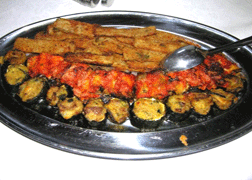 |
|
Vegetable antipasti at Azienda Fontansalsa
|
development work and to live all over the world. Then, two years after we were married,
his oldest brother died very unexpectedly and the farm and his ageing parents fell on our shoulders. He has another brother who lives in Milan and is a painter, but had no intention of coming home to look after things. So Tonino had to and that changed the course of our lives enormously.
When and why did you start to write?
MTS: I’ve always loved to write, but I grew up feeling I didn’t have anything to say. I believed that you needed to have something important to say if you were going to write; otherwise you shut up.
It’s peculiar to me when I look back. I went to schools, Nightingale-Bamford in New York and then Radcliffe, where a great deal of writing was required of me. I loved to write and was good at writing, but just never took it into consideration as a profession. Then I did a book for children in Italian during the 1970s, but I think what started me…Actually I know what started me writing — In about 1980 the Radcliffe Alumnae Association sponsored a trip around Sicily and asked me to go along. I thought: “Oh dear, now I have to read all the books about Sicily I’ve been meaning to read for the past twenty years and then try to remember them all.” What I did in the bus going around Sicily was much what I’ve done this week with you all attending the Oldways Symposium, commenting on the food, vegetables, what was growing in the fields, how it’s harvested, cooked, vignettes of Sicilian life as such. During the Radcliffe tour I realized that, without being conscious of it, I’d absorbed an enormous amount of information about Sicily and that my explanations added a great deal to the group’s understanding of what it was seeing.
We’d rebuilt our farmhouse after the 1968 earthquake; we’d been spending summers there since 1976. Over the years I’d gotten more and more interested in the farm, in the garden, and in watching the seasonal cycles and the year go by, so after the Radcliffe tour I decided to write my first book. I had meant to write a book of months, but then it turned out to be much more autobiographical than I would have ever thought. My own story crept in as I wrote On Persephone’s Island.
I know you’ve written many articles for the New York Times Travel Section and its “Sophisticated Traveler,” but can you give me a brief bibliography and thumb nail sketch of your books?
MTS: After On Persephone’s Island came Pomp and Sustenance. On Persephone’s Island came out in 1986; Pomp and Sustenance in 1989. After that I got involved in a project with a botanist which I abandoned because it wasn’t going anywhere. Then I realized that Maria Grammatico’s story, Bitter Almonds, really deserved to be preserved, put down on paper. The whole question of convent sweets (now a lot has been written on convent pastry making, the tradition, the recipes) was shockingly totally ignored until a relatively short time ago. I was a pioneer in this field. With a few exceptions nobody else was interested in the subject then.
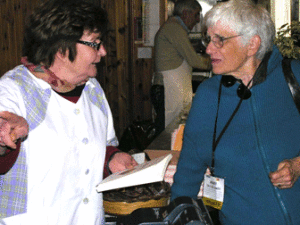 |
|
Maria Grammatico & Mary Taylor Simeti
|
Do you write at a particular time of day? On a computer?
MTS: In the mornings. It’s very hard though. When I lived in Palermo up until 1990, it was easier. I thought it would be easier to write in the country, but it isn’t. The farm encroaches upon me terribly and I’ve had a lot of family distractions. My visual artist son and his two kids, now in New York City, were living across the courtyard for three years. I never managed to impose respect for my own hours. I’ve written so little in the last eight years really. I mean I’ve published some short pieces and my manuscript of five essays on food and literature in Italian will be published by the palermitano publisher Flaccovio Editore next fall. Its working title is Fumo e Arrosto. Cinque escursioni nel paesaggio letterario e gastronomico della Sicilia. I stayed at the American Academy in Rome last year to clean it up and finish it off.
I write on a computer now. For my first book I didn’t have a computer. The first thing I did when I got my advance for On Persephone’s Island was to go out and buy a computer because I’d had to retype the whole manuscript in five copies with carbon paper before submitting it to the publisher. So I said “never again.”
I also wrote out Pomp and Sustenance by hand, but since then I’ve always used a computer. For my next book, whatever that book will be and whenever it will be, if I have the time, I think I might like to write it out by hand, even though I get terrible cramps in my hands these days if I write for too long stretches. I think the moment of transferring the text into the computer, typing it out, is the time when I do a lot of important editing.
How did you meet the pastry chef Maria Grammatico?
MTS: I was asked by the guest curator of a confectionary show at the American Crafts Museum in New York, sadly no longer in existence, to get some samples of Sicilian
confectionary work. I knew that Maria Grammatico made a particular kind of marzipan paschal lamb that was lying down so it was supposed to be the slaughtered lamb. I thought that was much more interesting than the mold of the seated lamb which is found everywhere in the world with variations in the icing. I knew Maria’s lamb was unique to Sicily so I went to Erice to ask her if she’d be willing to contribute one of her lambs to the show. It took a number of visits before we got our act together. Each time she would tell me a little story about her life and how she’d learned to make these marzipan pastries in the convent. She played me in like a fish. I proposed an article on her to Gourmet(1990) and then she persuaded me to expand it into a book.
Is there a kind of connecting thread, besides Sicily obviously, that led you from one book to another?
MTS: To a certain extent you can say that each is born of the one that came before. I did not set out to write my first two books as they became during their writing. As I said before, On Persephone’s Island was to have been a book of months which became much more autobiographical than I had ever intended to make it. When Knopf bought On Persephone’s Island, I had an agent whom I’d only ever met by phone until then. He came to Italy on vacation, met me in Rome with the contract for me to sign, and walked me step-by-step through the publishing production process. An unfamiliar world to me until then!
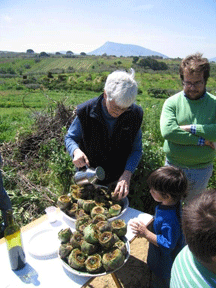 |
| Mary Simeti preparing roast artichokes for the Easter Monday picnic at Bosco. photo courtesy MTS |
He told me it would take a year from the time I signed the contract in hand until the time my book would come out. He warned me that it would be hard to await “the birth of your first child” and suggested that I think up a second book project, not necessarily ambitious, to keep my mind off the wait for On Persephone’s Island. So I told him, as I was
researching and writing On Persephone’s Island, I’d gotten interested in the stories, myths, beliefs, and history surrounding Sicilian food and so would like to do a few essays which might turn into another book. An essay on olive oil, an essay on bread…So I started reading and researching and three years later I published Pomp and Sustenance.
Let me say this. At the time I had absolutely no idea about how changed the American food world was from when I’d moved to Italy nearly twenty years before, and how much food and recipe writing had become a science, how particular and thirsty for accurate and practical information people now were. I was really totally unprepared and untrained for this, rushing in like a fool. Gourmetbought one of the chapters to come out the same month that Pomp and Sustenance was being published. One day I received a phone call from a woman saying “I am so and so from Gourmet’s test kitchens and I’m going to test your recipes” and I thought to myself “Oh dear, now the fat’s hit the fan.” She went on to ask me “What kind of sesame seeds, bay leaves, basil etc. etc. do you use?” I had no idea what to answer because I couldn’t, of course, say “the ones from my local deli, the ones in my kitchen or from my garden.” It turned out all right in the end because the ingredients and cooking methods that most excited the editors at Gourmet were so obvious to me living here in Sicily.
As probably the best-known American living in Sicily, how would you describe Sicilian cuisine to someone who was unfamiliar with it?
MTS: Fusion cuisine, but a fusion which took place over twenty five centuries of developing tastes and with ingredients from all over the Mediterranean.
Do you have two or three favorite dishes that you’d miss if the doctor said: “Mary, you can never eat this again”?
MTS: Soups. I love vegetable pasta dishes. I never get tired of pasta especially in summer with eggplant. I also love freshly-made hot ricotta straight out of the famer’s pot and what we Sicilians call Tenerumi. They are the tender, trailing, shoots of the yard-long zucchini you’ve seen in the markets of Vucciria, Ballarò and Capo. Sicilian ice-cream is to-die-for.
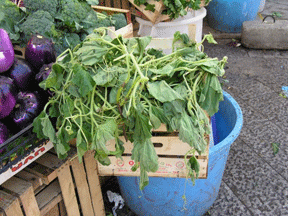 |
|
Mary Simeti’s favorite — tenerumi — on sale at the Capo market in Palermo
|
Do you enjoy cooking?
MTS: Yes, I do, but I’ve been cooking two main meals a day for 45 years so it’s getting a bit tiresome, frankly. People here, especially in the country, go out to eat a lot less than in the States. Here on the farm I’m the meal source twice a day. My cooking is low-maintenance. For example, I brought the seeds for corn-on-the-cob over from America and I put the water on to boil before I pick the ears. My vegetables are so incredibly good, and we produce excellent olive oil, so why not?
As you know I interviewed Dun Gifford last year for www.Epicurean-Traveler.com. How did you come to know Oldways? Did you find them, or did they seek you out as an authority on Sicily?
MTS: Oldways found me a long time ago in 1992. They held their first big conference in Spain; it was called “Food, Culture, and Discovery: Columbus to the 21st Century.” It started with two nights in Barcelona, then five in Seville, and three in Madrid. Historians, anthropologists, the cream of the food writing world….I was in way over my head. One of the organizers was food critic, journalist, author Nancy Harmon Jenkins, an authority of Mediterranean cuisine. I knew her through my brother. She put my name on the list and I got invited. I was very excited, but felt totally inadequate to the occasion. I called up my friend the food writer Faith Heller Willinger in Florence, who with Carol Field was the only person I knew who would be attending, and asked her, “What does anybody wear?” She said, “You know, Mary, in the food world there are a lot of very large people. They don’t dress; they drape.”
At the first fancy meal I found myself sitting next to Jeffrey Steingarten, the food critic at Vogue. Fortunately, I didn’t know enough to know how awesome, how much of an authority he was. Anyway you can’t get much in edgewise with Jeffrey so I just shut up and listened.
After this Spain experience, I went to the Oldways symposiums in Tunisia, Lecce, and Rome, where you were too, you said.
You lived many years in Palermo before moving to your husband’s family farm sixty kilometers from here. Any restaurant suggestions for Palermo?
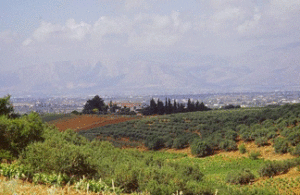 |
|
View of Bosco Falconeria. photo courtesy MTS
|
MTS: Al Cascinari near the Capo Market [Via D’Ossuna 43-45, tel. 091-6519804], and Piccolo Napoli [Piazzetta Mulino a Vento 4, tel.-091-320431, opened only at lunch Monday through Thursday, and evenings Friday and Saturday; closed Sunday and two weeks during August] are my favorites. Another not to be missed because it’s a happening and Palermo’s first restaurant which refused to pay the pizzo, or kickback, to the mafia is Antica Focacceria San Francesco [Via San Paternostro 58, tel. 091-320264, always open except Tuesday during the summer].
Sicily is world-renown for its sweets. Besides Maria Grammatico are there any other pastry chefs or ice-cream makers not to be missed?
MTS: Bar Costa [Via Alfieri Vittorio 13, tel. 345652], Pasticceria Alba [Piazza Don Bosco7/c-d, off Via della Libertà, O91-309016, www.baralba.it], and Bar Scimone near the Cathedral [Viale Regina Margherita 61, tel. 091-6841788, www.pasticceriascimone.it].
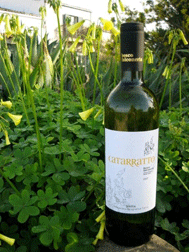
Bosco Falconeria wine
You not only write about Sicily and Sicilian history and food, but you and your husband, a retired professor of Agricultural Economy at the University of Palermo, live on a working farm. Where is it and what do you produce? How long has it been in his family?
MTS: It’s 60 kilometers west of Palermo in the municipality of Partinico, but when we think about it, we’re at Alcamo. We were one of the early early organic farms in Sicily. We produce vegetables, fruit: table grapes, some citrus, peaches, pears, loquats, persimmons, wine, and olive oil.
Tonino’s grandfather bought Bosco in 1933; it’s 17 acres. He already owned other land and was a wine producer. Our website is www.boscofalconeria.it. Bosco Falconeria is also our trademark. With our former museum administrator daughter, Natalia, and her Finnish husband, Rami Salo , a Tai Chi Chuan instructor, we are working towards opening it as an agriturismo. We have two apartments that we plan to start renting out in September, either as a B&B or as little apartments to rent. Eventually we also hope to have studios for artists and a conference center for seminars. A place for people who want to come and write or paint. Not for three-night stands.
& & &
